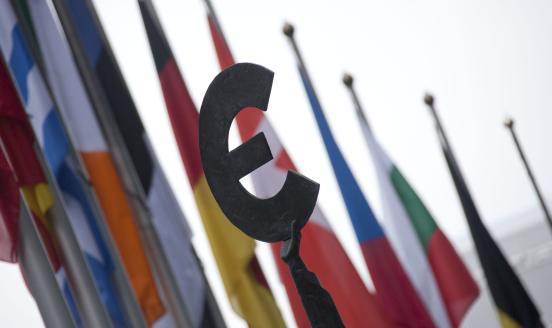The euro-area rebalancing challenge
The euro area faces a process of significant internal rebalancing. Over last decade, intra-area imbalances have grown on a number of macroeconomic dimensions. Southern Europe has massively lost competitiveness and built up large current account deficits vis-à-vis the North, where industrial activity has been increasingly concentrating (Figures 1 and 2). After remaining on a declining path until 2008, public debt has risen to unprecedented debt levels. Private debt – initially very low compared to the North – has grown impressively, promising hard times of private deleveraging ahead (Figures 3 and 4, studied in detail by my colleagues Ahearne and Wolff).
Successful rebalancing is vital for the future of the euro. If it does not take place, cohabitation between a relatively prosperous North and a debt-ridden, low-employment South is bound to be increasingly uneasy, ultimately undermining the existence of the European currency. Furthermore it has to proceed at a sustained and fast-enough pace, because a protracted adjustment process would not be politically sustainable.
Figure 1
Figure 2
Figure 3
Figure 4
Figure 5
Figure 6
Note: groups’ total for GDP, current account, Public and Private Debt. Group average for REER and unemployment rates (weighted by country’s share in groups’ total GDP).
So far, Europe has largely treated the issue of adjustment in the Southern countries as a one-sided process. After the global crisis and as first strains appeared in Europe,it was hoped that budgetary adjustment in Southern Europe could deliver both fiscal sustainability and a return to competitiveness, without the North having to deviate from its policy course. Fortunately however, policymakers are increasingly realising that competitiveness is a relative concept and economic conditions in the North affect the adjustment process in the South. Recent declarations by German Finance Minister Wolfgang Schäuble and by Bundesbank chief economist Jens Ulbrich, as well as the May 2012 wage agreement in the Germany metal industry, go in this direction. However we are still far from a policy consensus: a clear and shared understanding of what are the implication of a two-sided approach to rebalancing is still missing.
The macroeconomics of North-South adjustment within the euro area
The issue of adjustment is being explored extensively from an empirical point of view by Bruegel’s scholars (see among others, previous contribution by Zsolt Darvas and Guntram Wolff). In a forthcoming paper with Silvia Merler, we try to complement this research by investigating in a formal way the relationship between medium-term competitiveness and fiscal adjustment. We start from a stylised model with two countries in a monetary union, North and South. The two countries have unequal size (North is bigger than South) and the initial conditions are that North is undervalued in real terms with respect to South. Consistently with our reading of the prevailing strategy, we assume that in order to correct this misalignment, South endeavours to regain competitiveness through implementing a more restrictive fiscal policy than North. Fiscal policy is restrictive in both groups of countries, as both have to restore the sustainability of public finances, but more so in the South where austerity is driven by real exchange-rate objectives on top of sustainability concerns alone.
In order to understand what is the effect of economic conditions in the North on the adjustment process in the South, we consider two scenarios. In the first one, ECB monetary policy aims at keeping inflation at 2 per cent in the North. The South therefore needs to deflate to regain competitiveness. This worsens the dynamics of its public debt, opening the question of whether fiscal adjustment undertaken in this context can ultimately be self-defeating. In the second scenario monetary policy aims at keeping inflation constant in the euro area as a whole. This results therefore in more monetary stimulus, inflation in the North is higher, and this in turn helps the debt dynamics in the South. This exercise gives a number of results that bear policy implications.
First, we find that there is no escape to relative austerity. In the medium run what determines the real exchange rate changes is ultimately the differential fiscal stance between the two groups of countries, so South needs to tighten significantly more than North in order to regain competitiveness.
Second, the pace of budgetary adjustment in the North has major implications for the South. The more North tightens, the more difficult it is for South to carry out the necessary adjustment and close the competitiveness gap. Undoubtedly all euro-area countries have to restore budgetary sustainability, but fiscal overkill in the North would be at the expense of successful North-South rebalancing.
Third, in a scenario where monetary policy targets price stability in the North, competitiveness improvement in the South requires very low inflation or deflation. This worsens the debt dynamics and jeopardises return to sustainability. This effect is larger, the larger the outstanding stock of debt. We find in fact that if the initial debt level of South is above a certain threshold, debt dynamics become perverse and fiscal retrenchment ends up being self-defeating.
Fourth, if monetary policy instead targets average inflation, higher inflation in the North helps the debt dynamics in South. We find that the initial debt threshold above which adjustment becomes self-defeating is higher in this scenario than in the other one. This means that acceptance of higher inflation in the North relaxes the competitiveness-sustainability trade-off in the South: competitiveness improvement becomes beneficial to budgetary sustainability in countries where it would otherwise be harmful.
Fifth, we also study the impact of structural reforms in the South that aim at increasing the responsiveness of wages to labour market conditions. The findings are that if the initial debt level is not too high, they improve the debt dynamics, relaxing the competitiveness-sustainability trade-off. Again, inflation in the North helps strengthen the favourable effects of structural reforms.
Policy implications
The stylised approach upon which this analysis is based is admittedly simplifying. Nevertheless, findings have important policy implications. This far, the policy discussion in Europe has focused on the need for policy changes in Southern Europe in isolation from policies in the North and has it has taken for granted that restoration of competitiveness and sustainability go hand-in-hand. A more comprehensive approach to internal rebalancing is needed.
If there was ever a moment to treat national economic policies as a matter of common interest, it is now. All countries in the euro area share a common interest in the success of the rebalancing, and all can contribute to it. Obviously, the burden of adjustment is bound to be uneven and it would be an illusion to believe that Southern Europe can deviate from budgetary retrenchment and structural reforms. No successful rebalancing can take place without a sustained implementation of budgetary and structural reform programmes. But the euro area as a whole can contribute too.
The ECB should make unambiguously clear to everyone that its price stability mandate applies to the euro area as a whole, not to individual countries, and that it has to be interpreted symmetrically, treating undershooting as equally undesirable as overshooting. It should make equally clear that to the extent prices in Southern Europe adjust, fulfilment of the price stability mandate arithmetically implies for several years inflation above two per cent in the North. This might go without saying, but the reality is that the ECB so far has not communicated clearly on the issue. Ambiguity is counter-productive as it gives the impression that the ECB itself would regard higher inflation in the North as a departure from its mandate.
Northern European governments should limit fiscal adjustment to what is needed for a gradual reduction of excessive public indebtedness and avoid the temptation of budgetary overkill. In particular, they should not set headline deficit targets that result in pro-cyclical tightening.
Northern Europe should also pledge to accept temporarily higher inflation as long as price stability is maintained in the euro area as a whole. In concrete terms, governments should accept that to the extent Southern Europe does adjust, the monetary policy of the ECB is likely to be too loose in the years ahead to maintain price stability in their countries and they should accept wage settlements significantly above those observed in the first decade of EMU. Furthermore, they should commit not to attempt at controlling domestic inflation through budgetary, tax, or income policies and authorities in charge of macroprudential policy should commit not to use it as monetary policy instrument in disguise.
Finally, the European Commission and the Eurogroup should monitor the internal rebalancing process and the way all countries in the euro area contribute to its success.
Endnote
This post draws on Silvia Merler and Jean Pisani-Ferry, “The Simple Macroeconomics of North-South Adjustment in the EMU”, forthcoming Bruegel 2012.
The definition of North, South and Centre in the figures above is an economic one. Starting from a series of indicators based on those in use for the EU’s Excessive Imbalances Procedure, countries within the euro area are categorised depending on their corresponding performance. North consists of Austria, Finland, Germany, Netherlands; Centre of Belgium, France; and South of Greece, Ireland, Italy, Portugal and Spain.



